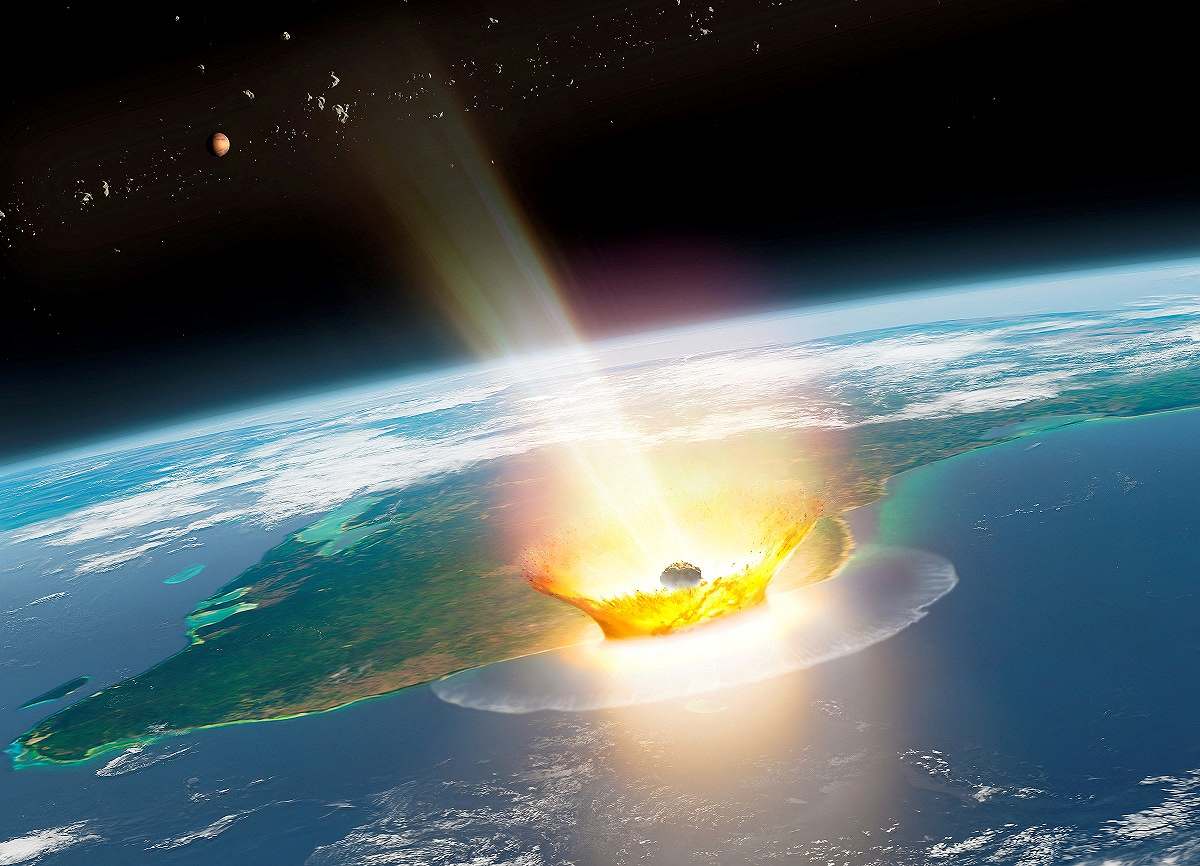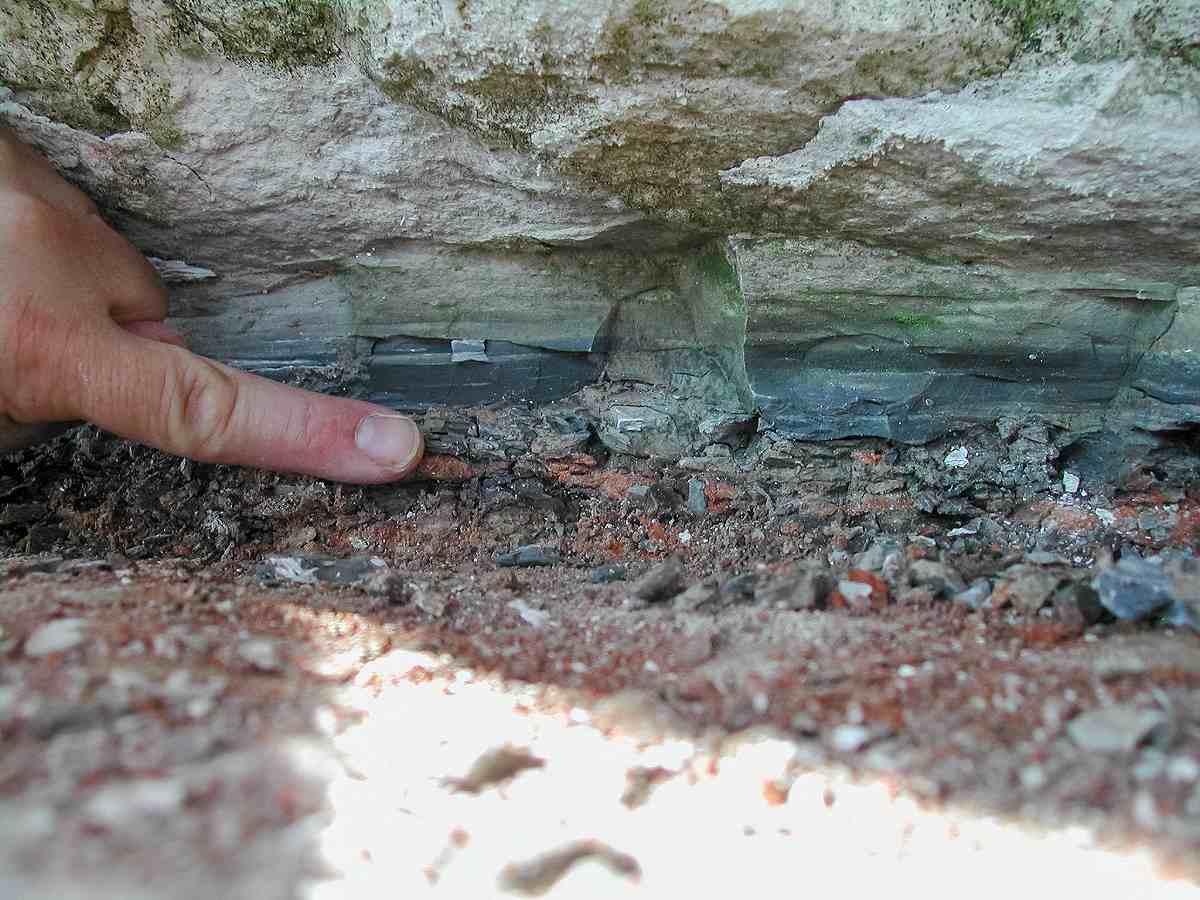
An artist’s impression of a large asteroid impacting at Chicxulub on the Mexican coastline, with the planet Mars and other asteroids in the background
18:03 JST, August 30, 2024
WASHINGTON (Reuters) — It was a turning point in the history of life on Earth. An asteroid an estimated 10-15 kilometers wide slammed into Mexico’s Yucatan Peninsula 66 million years ago, triggering a global cataclysm that eradicated about three-quarters of the world’s species and ended the age of dinosaurs.
The impact pulverized the asteroid and spread its debris worldwide, still present in a global layer of clay deposited in the aftermath of that fateful day. A new analysis of this debris has resolved a long debate about the nature of the asteroid, showing that it was a type that originated beyond Jupiter in the outer solar system.
The impactor, based on the debris composition, was a carbonaceous asteroid, or C-type, so named because of a high concentration of carbon. The study ruled out that the impactor was a comet or that the debris layer had been laid down by volcanism, as some had hypothesized.
“A projectile originating at the outskirts of the solar system sealed the fate of the dinosaurs,” said geochemist Mario Fischer-Godde of the University of Cologne in Germany, lead author of the study published on Aug. 15 in the journal Science.
The impact at the end of the Cretaceous Period gouged the Chicxulub (pronounced CHIK-shu-loob) crater, 180 kilometers wide and 20 kilometers deep. The clay layer is rich in metals including iridium, ruthenium, osmium, rhodium, platinum and palladium that are rare on Earth but common in asteroids.

The 66-million-year-old Cretaceous-Paleogene boundary layer at Stevns Klint in Denmark is seen in this undated photo obtained on Aug. 14.
The researchers focused upon ruthenium — specifically, the ratio of its isotopes present in the clay layer. Isotopes are atoms of the same element with slightly different masses because of differing numbers of subatomic particles called neutrons. Ruthenium has seven isotopes, with three especially important in the findings. The ruthenium isotope ratios matched other known carbonaceous asteroids.
“Ruthenium is especially useful in this context as the isotopic signature in the clay layer is almost entirely made up of ruthenium from the impactor and not the background sediment, and ruthenium shows distinct isotopic compositions between inner and outer solar system materials,” said geoscientist and study coauthor Steven Goderis of Vrije Universiteit Brussel in Belgium.
C-type asteroids, among the solar system’s most ancient objects, are the most common asteroid type, followed by stony S-type asteroids and rarer metallic M-type asteroids. Compositional differences among asteroids arise from how far from the sun they formed.
“The C-type asteroids represent leftover building blocks of the outer solar system’s gas and ice planets, whereas the S-type asteroids are the primary building blocks of terrestrial planets like Earth” in the inner solar system, Fischer-Godde said.
After forming in the outer solar system, the asteroid probably later migrated inward to become part of the main asteroid belt between Mars and Jupiter, Fischer-Godde said, before somehow being sent hurtling in the direction of Earth, perhaps due to a collision.
“All meteorites falling onto Earth, which are fragments from both C-type and S-type asteroids, originate from the asteroid belt. So it appears to be most likely that the [end-Cretaceous] impactor also originates from the asteroid belt,” Fischer-Godde said. “But there are also many bodies stored in the Kuiper Belt and in the Oort Cloud (regions far beyond the outermost planet Neptune), and basically not much is known about the composition of these bodies.”
The researchers analyzed samples from five other asteroid impacts dating from 37 million to 470 million years ago, finding that all were S-type, illustrating the rarity of a carbonaceous asteroid strike.
Dinosaurs had long ruled the land but, aside from their bird lineage, were wiped out following the impact, as were the flying reptiles called pterosaurs, the large marine reptiles and other sea life including many marine plankton species.
The mammals made it through, allowing these furry critters to eventually dominate the land and setting the stage for our species to arise roughly 300,000 years ago.
“I think without this cosmic coincidence of an asteroid impact,” Fischer-Godde said, “life on our planet would probably have developed vastly differently.”
Related Tags
"Science & Nature" POPULAR ARTICLE
-

Genome Study Reveals Milestone in History of Cat Domestication
-

Big Leap in Quest to Get to Bottom of Climate Ice Mystery
-

Security Camera Footage Vulnerable to Outside Access; Investigation Finds 3,000 Pieces Exposed Online
-

Paws on Parade: Nairobi’s Dogs Dazzle at ‘Pawchella’
-

Japan Set to Participate in EU’s R&D Framework, Aims to Boost Cooperation in Tech, Energy
JN ACCESS RANKING
-

Keidanren Chairman Yoshinobu Tsutsui Visits Kashiwazaki-Kariwa Nuclear Power Plant; Inspects New Emergency Safety System
-

Imports of Rare Earths from China Facing Delays, May Be Caused by Deterioration of Japan-China Relations
-

Tokyo Economic Security Forum to Hold Inaugural Meeting Amid Tense Global Environment
-

University of Tokyo Professor Discusses Japanese Economic Security in Interview Ahead of Forum
-

Japan Pulls out of Vietnam Nuclear Project, Complicating Hanoi’s Power Plans























